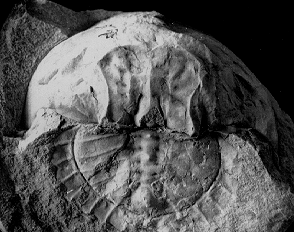 |
|
Horseshoe crabs have been around in one guise or another for quite some time now, let's just say since the Lower Silurian
for arguments sake. The earliest examples discovered date to about 435 million years old. Personally, I reckon they'll outlive
that troublesome species Homo sapiens hands (or at least pincered feet) down. Why? Well, because they are good at what they
do and they don't seem to have any intention of changing their mode of life or gross body morphology. This is why they are
often refered to as 'Living fossils'.
|
 |
|

|
 |
|
 |
|

The black and white photograph above is of an Upper Carboniferous horseshoe crab which lived almost 310 Million years ago
in the pools, rivers and lakes where coal deposits were laid down.
This particular fossil is named Euproops rotundatus
(Prestwich, 1840) and comes from strata of Westphalian B age in the West Midlands of England (Coseley).
|
|



